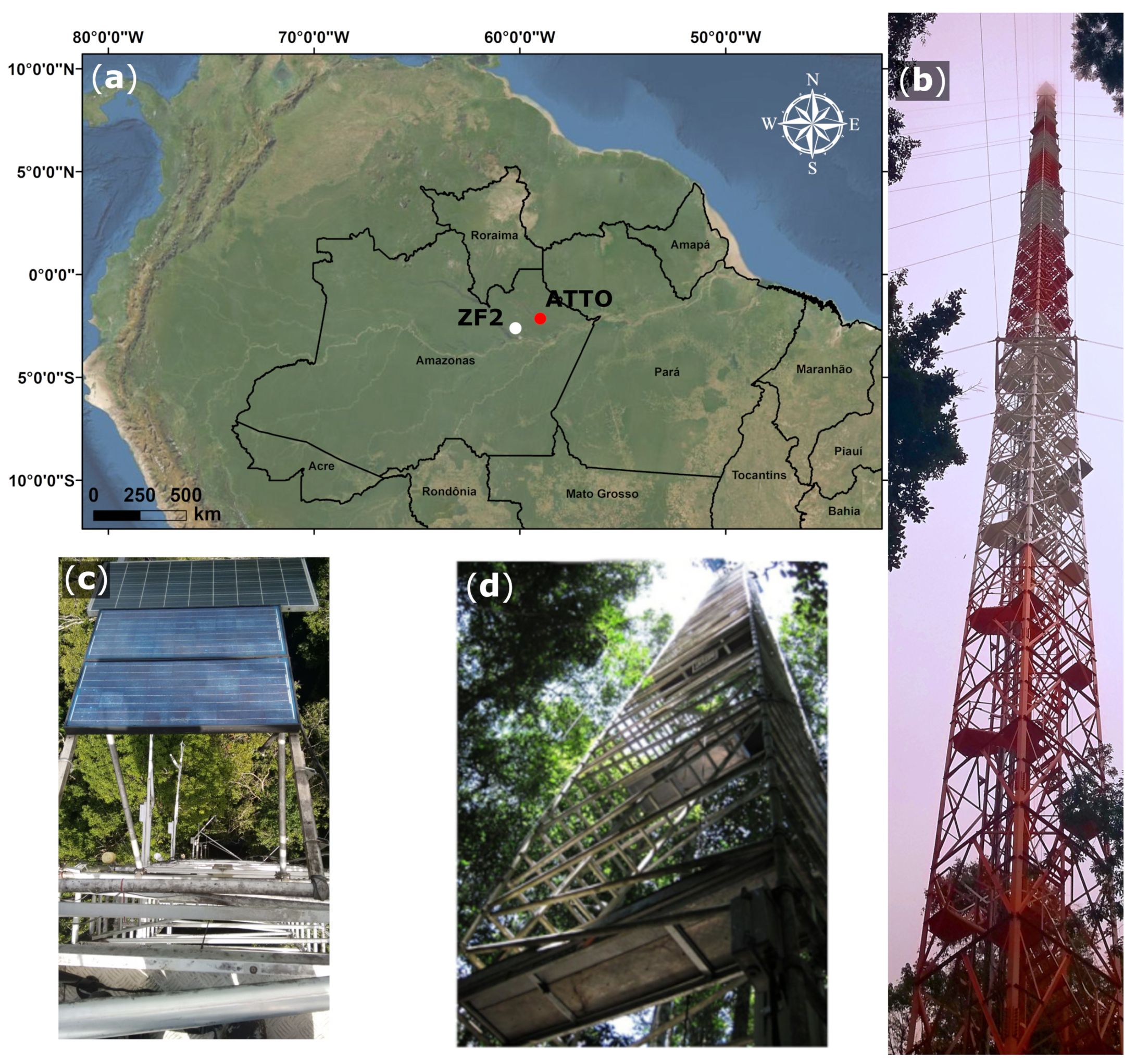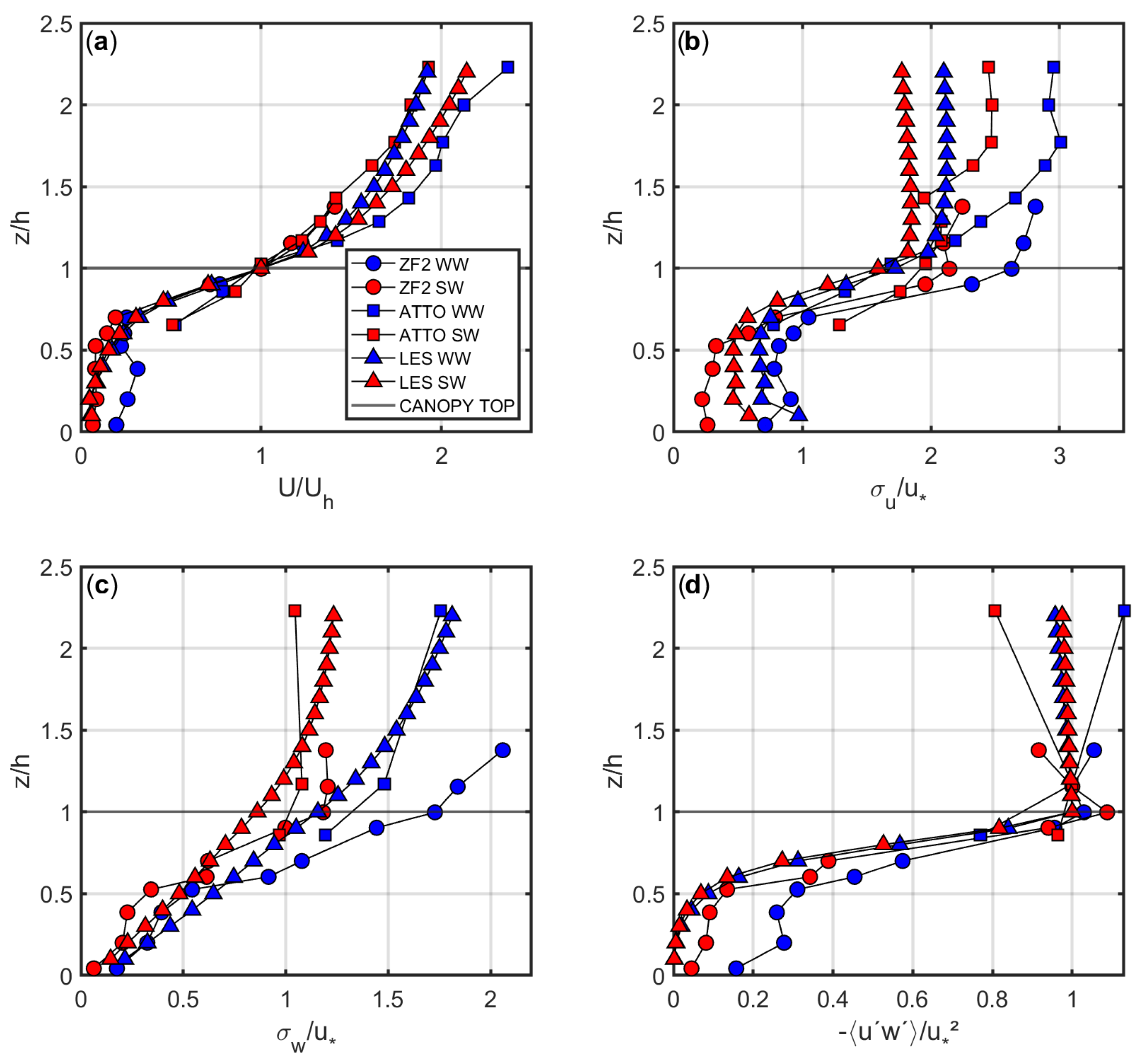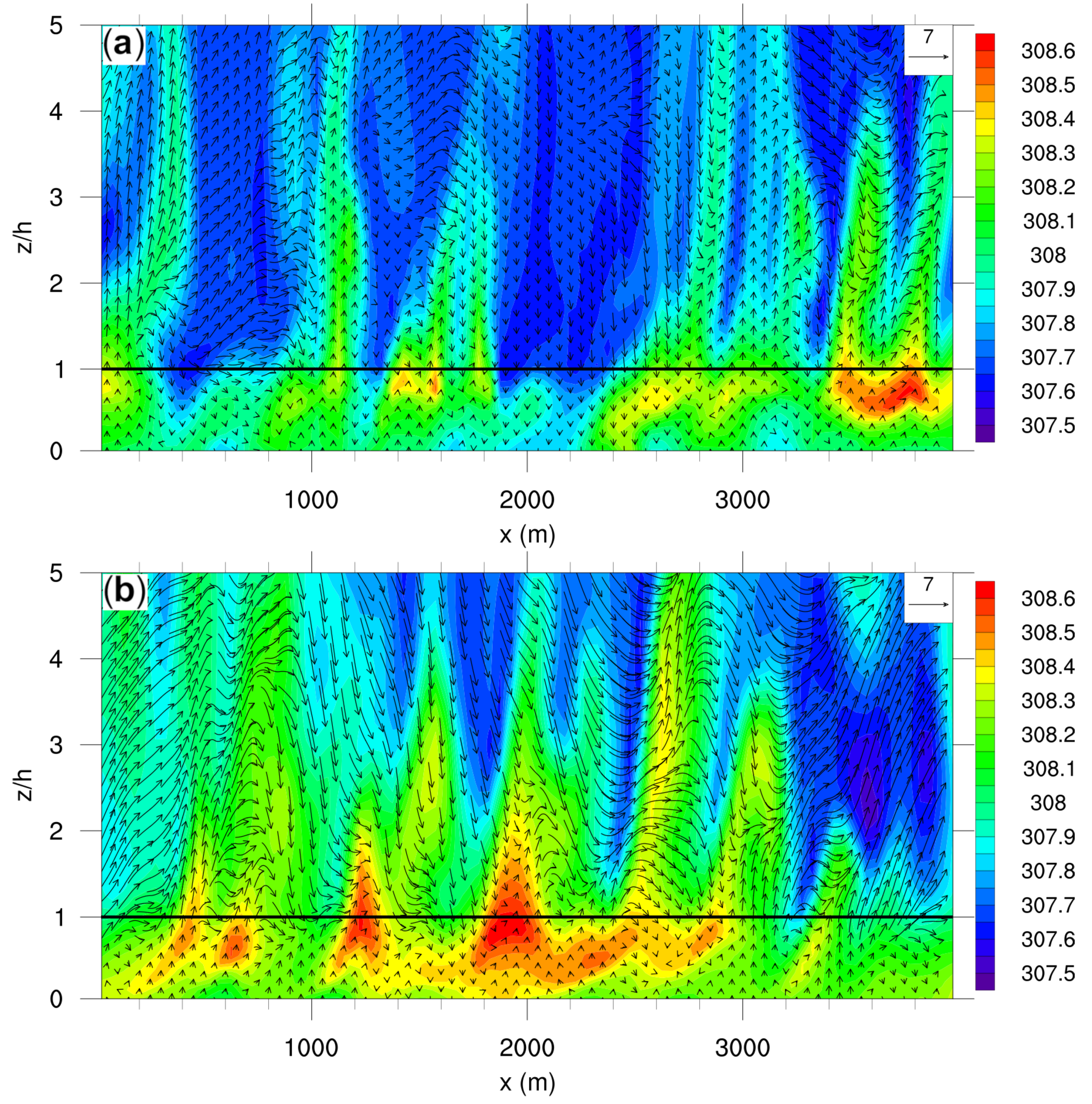Simulation of the Scalar Transport above and within the Amazon Forest Canopy
Abstract
:1. Introduction
2. Materials and Methods
2.1. Experimental Site and Data
2.2. Canopy Structure/Model Description
2.3. Initial and Boundary Conditions
3. Results and Discussion
3.1. Simulated and Measured Profiles
3.2. Temperature and Passive Scalar within and above the Forest Canopy
4. Conclusions
Author Contributions
Funding
Institutional Review Board Statement
Informed Consent Statement
Data Availability Statement
Conflicts of Interest
References
- Thom, A.; Stewart, J.; Oliver, H.; Gash, J. Comparison of aerodynamic and energy budget estimates of fluxes over a pine forest. Q. J. R. Meteorol. Soc. 1975, 101, 93–105. [Google Scholar] [CrossRef]
- Högström, U.; Bergström, H. Organized Turbulence Structures in the Near-Neutral Atmospheric Surface Layer. J. Atmos. Sci. 1996, 53, 2452–2464. [Google Scholar] [CrossRef] [Green Version]
- Simpson, I.; Edwards, G.; Thurtell, G.; Den Hartog, G.; Neumann, H.; Staebler, R. Micrometeorological measurements of methane and nitrous oxide exchange above a boreal aspen forest. J. Geophys. Res. Atmos. 1997, 102, 29331–29341. [Google Scholar] [CrossRef]
- Zahn, E.; Dias, N.L.; Araújo, A.; Sá, L.D.A.; Sörgel, M.; Trebs, I.; Wolff, S.; Manzi, A. Scalar turbulent behavior in the roughness sublayer of an Amazonian forest. Atmos. Chem. Phys. 2016, 16, 11349–11366. [Google Scholar] [CrossRef] [Green Version]
- Chor, T.L.; Dias, N.L.; Araújo, A.; Wolff, S.; Zahn, E.; Manzi, A.; Trebs, I.; Sá, M.O.; Teixeira, P.R.; Sörgel, M. Flux-variance and flux-gradient relationships in the roughness sublayer over the Amazon forest. Agric. For. Meteorol. 2017, 239, 213–222. [Google Scholar] [CrossRef]
- Tajchman, S.J. Comments on measuring turbulent exchange within and above forest canopy. Bull. Am. Meteorol. Soc. 1981, 62, 1550–1559. [Google Scholar] [CrossRef] [Green Version]
- Blanken, P.; Black, T.A.; Neumann, H.H.; Den Hartog, G.; Yang, P.C.; Nesic, Z.; Staebler, R.; Chen, W.; Novak, M.D. Turbulent Flux Measurements Above and Below the Overstory of a Boreal Aspen Forest. Bound.-Layer Meteorol. 1998, 89, 109–140. [Google Scholar] [CrossRef]
- Araújo, A.C.; Nobre, A.D.; Kruijt, B.; Elbers, J.A.; Dallarosa, R.; Stefani, P.; von Randow, C.; Manzi, A.O.; Culf, A.D.; Gash, J.H.C.; et al. Comparative measurements of carbon dioxide fluxes from two nearby towers in a central Amazonian rainforest: The Manaus LBA site. J. Geophys. Res. Atmos. 2002, 107, LBA-58. [Google Scholar] [CrossRef] [Green Version]
- Tóta, J.; Fitzjarrald, D.R.; Staebler, R.M.; Sakai, R.K.; Moraes, O.M.M.; Acevedo, O.C.; Wofsy, S.C.; Manzi, A.O. Amazon rain forest subcanopy flow and the carbon budget: Santarém LBA-ECO site. J. Geophys. Res. Biogeosci. 2008, 113, G00B02. [Google Scholar] [CrossRef]
- Katul, G.G.; Oren, R.; Manzoni, S.; Higgins, C.; Parlange, M.B. Evapotranspiration: A process driving mass transport and energy exchange in the soil-plant-atmosphere-climate system. Rev. Geophys. 2012, 50. [Google Scholar] [CrossRef] [Green Version]
- Dias-Júnior, C.Q.; Sá, L.D.; Filho, E.P.M.; Santana, R.A.; Mauder, M.; Manzi, A.O. Turbulence regimes in the stable boundary layer above and within the Amazon forest. Agric. For. Meteorol. 2017, 233, 122–132. [Google Scholar] [CrossRef]
- Dupont, S.; Brunet, Y. Influence of foliar density profile on canopy flow: A large-eddy simulation study. Agric. For. Meteorol. 2008, 148, 976–990. [Google Scholar] [CrossRef]
- Patton, E.G.; Katul, G.G. Turbulent pressure and velocity perturbations induced by gentle hills covered with sparse and dense canopies. Bound.-Layer Meteorol. 2009, 133, 189–217. [Google Scholar] [CrossRef]
- Dias-Júnior, C.Q.; Marques Filho, E.P.; Sá, L.D. A large eddy simulation model applied to analyze the turbulent flow above Amazon forest. J. Wind Eng. Ind. Aerodyn. 2015, 147, 143–153. [Google Scholar] [CrossRef]
- Kanani-Sühring, F.; Raasch, S. Enhanced scalar concentrations and fluxes in the lee of forest patches: A large-eddy simulation study. Bound.-Layer Meteorol. 2017, 164, 1–17. [Google Scholar] [CrossRef]
- Liu, Z.; Ishihara, T.; He, X.; Niu, H. LES study on the turbulent flow fields over complex terrain covered by vegetation canopy. J. Wind Eng. Ind. Aerodyn. 2016, 155, 60–73. [Google Scholar] [CrossRef]
- Chen, X.; Massman, W.J.; Su, Z. A column canopy-air turbulent diffusion method for different canopy structures. J. Geophys. Res. Atmos. 2019, 124, 488–506. [Google Scholar] [CrossRef]
- Chen, B.; Chamecki, M.; Katul, G.G. Effects of Gentle Topography on Forest-Atmosphere Gas Exchanges and Implications for Eddy-Covariance Measurements. J. Geophys. Res. Atmos. 2020, 125. [Google Scholar] [CrossRef]
- Raupach, M.R.; Finnigan, J.J.; Brunei, Y. Coherent eddies and turbulence in vegetation canopies: The mixing-layer analogy. Bound.-Layer Meteorol. 1996, 78, 351–382. [Google Scholar] [CrossRef]
- de Souza, C.M.; Dias-Júnior, C.Q.; Tóta, J.; de Abreu Sá, L.D. An empirical-analytical model of the vertical wind speed profile above and within an Amazon forest site. Meteorol. Appl. 2016, 23, 158–164. [Google Scholar] [CrossRef] [Green Version]
- Robinson, S.K. Coherent Motions in the Turbulent Boundary Layer. Annu. Rev. Fluid Mech. 1991, 23, 601–639. [Google Scholar] [CrossRef]
- Katul, G.; Kuhn, G.; Schieldge, J.; Hsieh, C.I. The ejection-sweep character of scalar fluxes in the unstable surface layer. Bound.-Layer Meteorol. 1997, 83, 1–26. [Google Scholar] [CrossRef]
- Dias-Júnior, C.Q.; Dias, N.L.; dos Santos, R.M.N.; Sörgel, M.; Araújo, A.; Tsokankunku, A.; Ditas, F.; de Santana, R.A.; Von Randow, C.; Sá, M.; et al. Is there a classical inertial sublayer over the Amazon forest? Geophys. Res. Lett. 2019, 46, 5614–5622. [Google Scholar] [CrossRef]
- Chamecki, M.; Freire, L.S.; Dias, N.L.; Chen, B.; Dias-Junior, C.Q.; Toledo Machado, L.A.; Sörgel, M.; Tsokankunku, A.; Araújo, A.C. Effects of vegetation and topography on the boundary layer structure above the Amazon forest. J. Atmos. Sci. 2020, 77, 2941–2957. [Google Scholar] [CrossRef]
- Warhaft, Z. Passive Scalars in Turbulent Flows. Annu. Rev. Fluid Mech. 2000, 32, 203–240. [Google Scholar] [CrossRef]
- Betts, A.K. Transport of ozone to the surface by convective downdrafts at night. J. Geophys. Res. 2002, 107, LBA-13. [Google Scholar] [CrossRef]
- Gerken, T.; Wei, D.; Chase, R.J.; Fuentes, J.D.; Schumacher, C.; Machado, L.A.; Andreoli, R.V.; Chamecki, M.; de Souza, R.A.F.; Freire, L.S.; et al. Downward transport of ozone rich air and implications for atmospheric chemistry in the Amazon rainforest. Atmos. Environ. 2016, 124, 64–76. [Google Scholar] [CrossRef] [Green Version]
- Dias-Júnior, C.Q.; Dias, N.L.; Fuentes, J.D.; Chamecki, M. Convective storms and non-classical low-level jets during high ozone level episodes in the Amazon region: An ARM/GOAMAZON case study. Atmos. Environ. 2017, 155, 199–209. [Google Scholar] [CrossRef] [Green Version]
- Melo, A.M.; Dias-Junior, C.Q.; Cohen, J.C.; Sá, L.D.; Cattanio, J.H.; Kuhn, P.A. Ozone transport and thermodynamics during the passage of squall line in Central Amazon. Atmos. Environ. 2019, 206, 132–143. [Google Scholar] [CrossRef]
- Zhuang, Y.; Amiro, B.D. Pressure Fluctuations during Coherent Motions and Their Effects on the Budgets of Turbulent Kinetic Energy and Momentum Flux within a Forest Canopy. J. Appl. Meteorol. Climatol. 1994, 33, 704–711. [Google Scholar] [CrossRef] [Green Version]
- Burns, S.P.; Sun, J.; Lenschow, D.H.; Oncley, S.P.; Stephens, B.B.; Yi, C.; Anderson, D.E.; Hu, J.; Monson, R.K. Atmospheric stability effects on wind fields and scalar mixing within and just above a subalpine forest in sloping terrain. Bound.-Layer Meteorol. 2011, 138, 231–262. [Google Scholar] [CrossRef] [Green Version]
- Cava, D.; Katul, G. On the scaling laws of the velocity-scalar cospectra in the canopy sublayer above tall forests. Bound.-Layer Meteorol. 2012, 145, 351–367. [Google Scholar] [CrossRef]
- Foken, T.; Aubinet, M.; Leuning, R. The eddy covariance method. In Eddy Covariance; Springer: Berlin/Heidelberg, Germany, 2012; pp. 1–19. [Google Scholar]
- Miranda, F.O.; Ramos, F.M.; von Randow, C.; Dias-Júnior, C.Q.; Chamecki, M.; Fuentes, J.D.; Manzi, A.O.; de Oliveira, M.E.; de Souza, C.M. Detection of extreme phenomena in the stable boundary layer over the Amazonian forest. Atmosphere 2020, 11, 952. [Google Scholar] [CrossRef]
- Aubinet, M. Eddy covariance CO2 flux measurements in nocturnal conditions: An analysis of the problem. Ecol. Appl. 2008, 18, 1368–1378. [Google Scholar] [CrossRef]
- Katul, G.; Finnigan, J.; Poggi, D.; Leuning, R.; Belcher, S. The influence of hilly terrain on canopy-atmosphere carbon dioxide exchange. Bound.-Layer Meteorol. 2006, 118, 189–216. [Google Scholar] [CrossRef]
- Belcher, S.E.; Harman, I.N.; Finnigan, J.J. The wind in the willows: Flows in forest canopies in complex terrain. Annu. Rev. Fluid Mech. 2012, 44, 479–504. [Google Scholar] [CrossRef]
- Shaw, R.H.; Schumann, U. Large-eddy simulation of turbulent flow above and within a forest. Bound.-Layer Meteorol. 1992, 61, 47–64. [Google Scholar] [CrossRef] [Green Version]
- Kanda, M.; Hino, M. Organized structures in developing turbulent flow within and above a plant canopy, using a large eddy simulation. Bound.-Layer Meteorol. 1994, 68, 237–257. [Google Scholar] [CrossRef]
- Finnigan, J.J.; Shaw, R.H.; Patton, E.G. Turbulence structure above a vegetation canopy. J. Fluid Mech. 2009, 637, 387–424. [Google Scholar] [CrossRef] [Green Version]
- Dupont, S.; Brunet, Y. Coherent structures in canopy edge flow: A large-eddy simulation study. J. Fluid Mech. 2009, 630, 93–128. [Google Scholar] [CrossRef]
- Shaw, R.H.; Patton, E.G.; Finnigan, J.J. Coherent Eddy Structures Over Plant Canopies. In Coherent Flow Structures at Earth’s Surface; John Wiley & Sons, Ltd.: Hoboken, NJ, USA, 2013; Chapter 10; pp. 149–159. [Google Scholar] [CrossRef]
- Patton, E.G.; Sullivan, P.P.; Shaw, R.H.; Finnigan, J.J.; Weil, J.C. Atmospheric stability influences on coupled boundary layer and canopy turbulence. J. Atmos. Sci. 2016, 73, 1621–1647. [Google Scholar] [CrossRef]
- Kanani-Sühring, F.; Raasch, S. Spatial variability of scalar concentrations and fluxes downstream of a clearing-to-forest transition: A large-eddy simulation study. Bound.-Layer Meteorol. 2015, 155, 1–27. [Google Scholar] [CrossRef]
- Neves, T.; Fisch, G.; Raasch, S. Local Convection and Turbulence in the Amazonia Using Large Eddy Simulation Model. Atmosphere 2018, 9, 399. [Google Scholar] [CrossRef] [Green Version]
- Carneiro, R.; Fisch, G.; Neves, T.; Santos, R.; Santos, C.; Borges, C. Nocturnal Boundary Layer Erosion Analysis in the Amazon Using Large-Eddy Simulation during GoAmazon Project 2014/5. Atmosphere 2021, 12, 240. [Google Scholar] [CrossRef]
- Andreae, M.O.; Acevedo, O.C.; Araùjo, A.; Artaxo, P.; Barbosa, C.G.G.; Barbosa, H.M.J.; Brito, J.; Carbone, S.; Chi, X.; Cintra, B.B.L.; et al. The Amazon Tall Tower Observatory (ATTO): Overview of pilot measurements on ecosystem ecology, meteorology, trace gases, and aerosols. Atmos. Chem. Phys. 2015, 15, 10723–10776. [Google Scholar] [CrossRef] [Green Version]
- Marques Filho, A.D.O.; Dallarosa, R.G.; Pachêco, V.B. Radiação solar e distribuição vertical de área foliar em floresta–Reserva Biológica do Cuieiras–ZF2, Manaus. Acta Amazon. 2005, 35, 427–436. [Google Scholar] [CrossRef]
- Santana, R.A.; Dias-Júnior, C.Q.; Tóta, J.; Fuentes, J.D.; do Vale, R.S.; Alves, E.G.; dos Santos, R.M.N.; Manzi, A.O. Air turbulence characteristics at multiple sites in and above the Amazon rainforest canopy. Agric. For. Meteorol. 2018, 260–261, 41–54. [Google Scholar] [CrossRef]
- Katul, G.G.; Mahrt, L.; Poggi, D.; Sanz, C. One-and two-equation models for canopy turbulence. Bound.-Layer Meteorol. 2004, 113, 81–109. [Google Scholar] [CrossRef] [Green Version]
- Queck, R.; Bienert, A.; Maas, H.G.; Harmansa, S.; Goldberg, V.; Bernhofer, C. Wind fields in heterogeneous conifer canopies: Parameterisation of momentum absorption using high-resolution 3D vegetation scans. Eur. J. For. Res. 2012, 131, 165–176. [Google Scholar] [CrossRef]
- Fuentes, J.D.; Chamecki, M.; dos Santos, R.M.N.; Randow, C.V.; Stoy, P.C.; Katul, G.; Fitzjarrald, D.; Manzi, A.; Gerken, T.; Trowbridge, A.; et al. Linking Meteorology, Turbulence, and Air Chemistry in the Amazon Rain Forest. Bull. Am. Meteorol. Soc. 2016, 97, 2329–2342. [Google Scholar] [CrossRef]
- Oliveira, P.E.S.; Acevedo, O.C.; Sörgel, M.; Tsokankunku, A.; Wolff, S.; Araújo, A.C.; Souza, R.A.F.; Sá, M.O.; Manzi, A.O.; Andreae, M.O. Nighttime wind and scalar variability within and above an Amazonian canopy. Atmos. Chem. Phys. 2018, 18, 3083–3099. [Google Scholar] [CrossRef] [Green Version]
- Raasch, S.; Schröter, M. PALM-A large-eddy simulation model performing on massively parallel computers. Meteorol. Z. 2001, 10, 363–372. [Google Scholar] [CrossRef]
- Maronga, B.; Gryschka, M.; Heinze, R.; Hoffmann, F.; Kanani-Sühring, F.; Keck, M.; Ketelsen, K.; Letzel, M.O.; Sühring, M.; Raasch, S. The Parallelized Large-Eddy Simulation Model (PALM) version 4.0 for atmospheric and oceanic flows: Model formulation, recent developments, and future perspectives. Geosci. Model Dev. 2015, 8, 2515–2551. [Google Scholar] [CrossRef] [Green Version]
- Maronga, B.; Banzhaf, S.; Burmeister, C.; Esch, T.; Forkel, R.; Fröhlich, D.; Fuka, V.; Gehrke, K.F.; Geletič, J.; Giersch, S.; et al. Overview of the PALM model system 6.0. Geosci. Model Dev. 2020, 13, 1335–1372. [Google Scholar] [CrossRef]
- Pope, S.B.; Pope, S.B. Turbulent Flows; Cambridge University Press: Cambridge, UK, 2000. [Google Scholar]
- Williamson, J. Low-storage Runge–Kutta schemes. J. Comput. Phys. 1980, 35, 48–56. [Google Scholar] [CrossRef]
- Patton, E.G.; Sullivan, P.P.; Davis, K.J. The influence of a forest canopy on top-down and bottom-up diffusion in the planetary boundary layer. Q. J. R. Meteorol. Soc. 2003, 129, 1415–1434. [Google Scholar] [CrossRef]
- Watanabe, T. Large-eddy simulation of coherent turbulence structures associated with scalar ramps over plant canopies. Bound.-Layer Meteorol. 2004, 112, 307–341. [Google Scholar] [CrossRef]
- Shaw, R.H.; Patton, E.G. Canopy element influences on resolved- and subgrid-scale energy within a large-eddy simulation. Agric. For. Meteorol. 2003, 115, 5–17. [Google Scholar] [CrossRef] [Green Version]
- Brown, K.W.; Covey, W. The energy-budget evaluation of the micrometeorological transfer processes within a cornfield. Agric. Meteorol. 1966, 3, 73–96. [Google Scholar] [CrossRef]
- Finnigan, J. Turbulence in Plant Canopies. Annu. Rev. Fluid Mech. 2000, 32, 519–571. [Google Scholar] [CrossRef]
- Dias-Júnior, C.; Sá, L.; Pachêco, V.; de Souza, C. Coherent structures detected in the unstable atmospheric surface layer above the Amazon forest. J. Wind. Eng. Ind. Aerodyn. 2013, 115, 1–8. [Google Scholar] [CrossRef]
- Poggi, D.; Porporato, A.; Ridolfi, L.; Albertson, J.D.; Katul, G.G. The Effect of Vegetation Density on Canopy Sub-Layer Turbulence. Bound.-Layer Meteorol. 2004, 111, 565–587. [Google Scholar] [CrossRef]
- Dwyer, M.J.; Patton, E.G.; Shaw, R.H. Turbulent kinetic energy budgets from a large-eddy simulation of airflow above and within a forest canopy. Bound.-Layer Meteorol. 1997, 84, 23–43. [Google Scholar] [CrossRef]
- Cassiani, M.; Katul, G.; Albertson, J. The effects of canopy leaf area index on airflow across forest edges: Large-eddy simulation and analytical results. Bound.-Layer Meteorol. 2008, 126, 433–460. [Google Scholar] [CrossRef] [Green Version]
- Tota, J.; Roy Fitzjarrald, D.; da Silva Dias, M.A. Amazon rainforest exchange of carbon and subcanopy air flow: Manaus LBA site—A complex terrain condition. Sci. World J. 2012, 2012, 165067. [Google Scholar] [CrossRef] [PubMed] [Green Version]






| Variables | Height a.g.l. (m) and Instruments Models | Sampling Rate (Hz) |
|---|---|---|
| ZF2 Tower 1.5, 7.0, 13.5, 18.4, 21.1, 24.5, 31.6, 34.9, 40.4 and 48.2 (CSAT3, Campbell Scientific Inc, Logan, UT. ) | 20 | |
| wind speed components (u, v, w) | ATTO Tower 80 m 14, 40 and 55 (CSAT3, Campbell Scientific Inc, Logan, UT.) 21 (Irgason, Campbell Scientific Inc, Logan, UT.) 81 Windmaster, Gill Instruments Limited, Lymington, UK | 10 |
| ATTO Tower 325 m 150 (CSAT3, Campbell Scientific Inc, Logan, UT.) 325 (Irgason, Campbell Scientific Inc, Logan, UT.) | 10 and 20 | |
| Air temperature and relative humidity | ATTO Tower 80 m 0.4, 1.5, 4.0, 12.0, 26.0, 36.0, 40.0, 55.0, 73.0 and 81.0 Termohygrometer (CS215, Rotronic Measurement Solutions, Switzerland) | 1/60 |
| Variable | Símbolo | Value |
|---|---|---|
| Horizontal domain size (km) | , | |
| Domain height (km) | 1.6 | |
| Grid resolution (m) | , , | 20 × 20 × 4 |
| Time step (s) | 1.0 | |
| Canopy height (m) | h | 40 |
| Leaf area index | 6.1 | |
| Surface temperature (K) | 302.38 | |
| Surface water vapor (g/kg) | q | 18.45 |
| Canopy top heat flux (K/s) | 0.1 | |
| Surface scalar flux (ppm/s) | 2 | |
| Spin up time (s) | - | 10,800 |
| Total Simulation time (s) | - | 14,400 |
| Canopy drag coefficient | 0.15 |
Publisher’s Note: MDPI stays neutral with regard to jurisdictional claims in published maps and institutional affiliations. |
© 2021 by the authors. Licensee MDPI, Basel, Switzerland. This article is an open access article distributed under the terms and conditions of the Creative Commons Attribution (CC BY) license (https://creativecommons.org/licenses/by/4.0/).
Share and Cite
Serra-Neto, E.M.; Martins, H.S.; Dias-Júnior, C.Q.; Santana, R.A.; Brondani, D.V.; Manzi, A.O.; de Araújo, A.C.; Teixeira, P.R.; Sörgel, M.; Mortarini, L. Simulation of the Scalar Transport above and within the Amazon Forest Canopy. Atmosphere 2021, 12, 1631. https://doi.org/10.3390/atmos12121631
Serra-Neto EM, Martins HS, Dias-Júnior CQ, Santana RA, Brondani DV, Manzi AO, de Araújo AC, Teixeira PR, Sörgel M, Mortarini L. Simulation of the Scalar Transport above and within the Amazon Forest Canopy. Atmosphere. 2021; 12(12):1631. https://doi.org/10.3390/atmos12121631
Chicago/Turabian StyleSerra-Neto, Edivaldo M., Hardiney S. Martins, Cléo Q. Dias-Júnior, Raoni A. Santana, Daiane V. Brondani, Antônio O. Manzi, Alessandro C. de Araújo, Paulo R. Teixeira, Matthias Sörgel, and Luca Mortarini. 2021. "Simulation of the Scalar Transport above and within the Amazon Forest Canopy" Atmosphere 12, no. 12: 1631. https://doi.org/10.3390/atmos12121631
APA StyleSerra-Neto, E. M., Martins, H. S., Dias-Júnior, C. Q., Santana, R. A., Brondani, D. V., Manzi, A. O., de Araújo, A. C., Teixeira, P. R., Sörgel, M., & Mortarini, L. (2021). Simulation of the Scalar Transport above and within the Amazon Forest Canopy. Atmosphere, 12(12), 1631. https://doi.org/10.3390/atmos12121631









